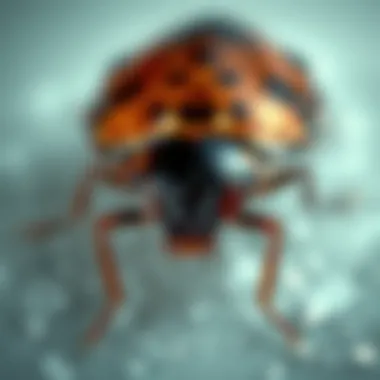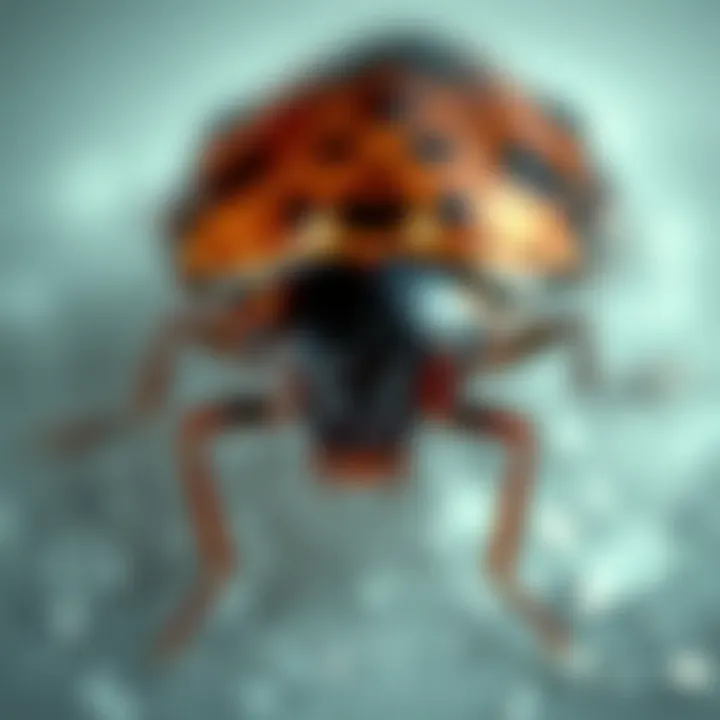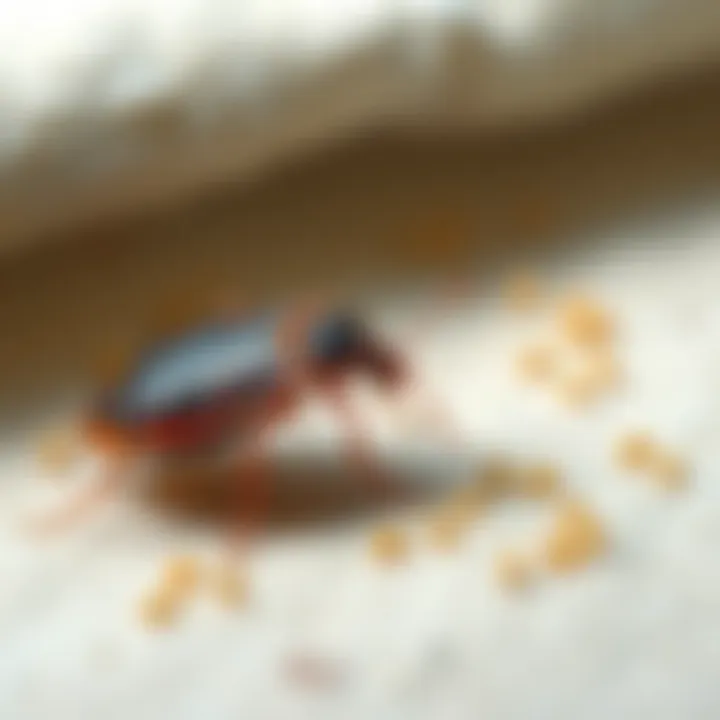Are Bed Bugs Poisonous? An In-Depth Exploration


Intro
Bed bugs have earned quite a reputation as pests that disrupt our lives, especially when they invade our personal spaces like bedrooms and hotels. However, there is often confusion regarding whether these insects are poisonous. This article looks to cut through the fog and brings light to this question, examining bed bugs from a biological perspective, their feeding habits, and how their bites affect humans. The goal is not just to answer a simple question but to delve deeper into the issue and provide an intricate understanding of what these critters really are.
Bed bugs, scientifically known as Cimex lectularius, are not the most charming houseguests. They latch onto humans and other warm-blooded animals for nourishment. While their bites can be bothersome, leading to itching and discomfort, the misconception surrounding their toxicity deserves scrutiny. By laying out the facts, this piece aims to clarify what bed bugs can and cannot do in terms of harm.
Additionally, the health implications of bed bug interactions are far from trivial. They can induce allergic reactions in some individuals, and the psychological effects of an infestation shouldn't be overlooked either. It’s crucial for both the public and researchers alike to grasp the full picture of what bed bugs bring to the table—dangerous or merely annoying?
As we wade through this topic, emphasis will be placed on realistic prevention methods and control tactics. With the rise of bed bug reports, understanding their habits and the implications for public health is more relevant than ever.
Ultimately, this guide strives to be a substantial resource aimed at students, researchers, educators, and professionals who seek clarity in the muddle of bed bug folklore and facts. Let’s embark on this journey to unravel the mystery, zeroing in on the essential points surrounding these small yet impactful insects, starting off with the methodologies that underpin our exploration.
Intro
The topic of bed bugs is significant not just for those experiencing an infestation, but also for students, researchers, educators, and professionals looking to understand the broader implications of these pests. Bed bugs are small, wingless insects that feed on human blood, often inciting worry and confusion in those who encounter them. Understanding whether bed bugs are poisonous is crucial in dispelling myths and addressing concerns surrounding health risks associated with their presence.
Moreover, examining the toxicity of bed bugs is more than just a technical inquiry; it has real-world consequences for public health. As human interaction with urban environments increases, so does the potential for bed bug infestations. These pests can easily hitch a ride on clothing or luggage, making education on their nature and behavior even more imperative.
Why This Matters
- Health Risks: Knowing how bed bugs can affect human health allows individuals to make informed decisions about prevention and treatment methods.
- Myth Busting: In an age rife with misinformation, addressing the misconception that bed bugs are poisonous helps clarify the actual dangers they pose.
- Impact on Communities: Understanding the dynamics of bed bug infestations sheds light on public health standards and informs legislative actions that might be necessary to combat these pests effectively.
The implications of understanding bed bug biology and behavior extend into various professional fields, including healthcare, pest control, urban planning, and even psychology. Thus, a comprehensive exploration into their characteristics, behaviors, and the effects of bites contributes valuable knowledge for both professionals and the general public.
With that framework set, the article will embark on an in-depth discussion of what bed bugs are, their feeding habits, and the potential health implications associated with their bites, aiming to provide clarity and insight into their role in the lives of humans.
Understanding Bed Bugs
Understanding bed bugs is crucial for both effective prevention and successful management of infestations. These tiny, elusive creatures play a significant role in various facets of human interaction, even though many might not think twice about them. By grasping fundamental aspects like their behavior, biology, and life cycle, one can develop strategies that not only limit their presence but also mitigate their potential health effects. Especially in settings such as households, accommodations, and even healthcare facilities, comprehensive knowledge about bed bugs influences how society deals with this persistent pest.
Taxonomy and Classification
Bed bugs belong to the Cimicidae family, and their scientific name is Cimex lectularius. This taxonomical classification places them among other similar pests, yet bed bugs are uniquely adapted to thrive alongside humans. They are not solely nocturnal like many other prodding insects but have exhibited an extraordinary ability to cohabit with human population centers throughout history.
Interestingly, close cousins like the Cimex hemipterus prefer warmer climates and differ slightly in habitat and behavior but ultimately have similar detrimental impacts on human health. Understanding their taxonomy helps in identifying and differentiating between various bed bug species.
Biological Characteristics
Bed bugs are flat, oval-shaped insects, roughly the size of an apple seed, about 4 to 5 mm long. Their coloration can range from brown to reddish-brown, becoming more vivid after a blood meal.
A few key characteristics set them apart:
- Life Cycle: Bed bugs undergo an incomplete metamorphosis, progressing through egg, nymph, and adult stages. Remarkably, females can lay up to five eggs daily, accumulating a potential of 500 eggs in their lifetime.
- Feeding Mechanism: Equipped with specialized mouthparts called beaks, bed bugs pierce the skin of hosts and withdrawal blood. This ingestion process can occur multiple times, and due to a unique anticoagulant in their saliva, the bite often goes unnoticed initially.
- Survival Adaptability: These pests can survive in various conditions and can withstand periods without food, making them elusive in their control. Notably, they can brave for several months without a blood meal, adapting their habits to endure unfavorable conditions, including temperature shifts or lifestyle changes in humans.
By understanding these biological traits and behaviors, individuals can establish more effective methods for prevention and control.
Feeding Habits of Bed Bugs
Understanding the feeding habits of bed bugs is crucial in getting a complete picture of their impact on human health and the environment. These pests, primarily known for their nocturnal habits and stealthy approaches, thrive by feeding on human blood. Recognizing their feeding behavior not only sheds light on their biology but also enhances our knowledge of how to effectively prevent and control infestations. Bed bugs are absent of any venom; their primary interaction with humanity revolves around the act of feeding, which unfortunately results in irritation and discomfort for many.
Dietary Preferences
Bed bugs, scientifically known as Cimex lectularius, have a tightly tailored diet focused almost exclusively on blood. While human blood is the primary source of sustenance for these parasites, they are not picky eaters by any stretch of the imagination. In emergencies, they have been known to feed on other mammals and poultry if human hosts are scarce. Their favorite delicacy, however, remains human blood due to its rich iron content, making it quite a nutrient-dense option for them.
They don’t discriminate based on age or health status; anyone can serve as a feast. New-borns to the elderly are at risk, though it is the younger cohorts who may often appear more attractive because their skin is generally softer and more readily accessible.
- Desirable Host Characteristics:


- Body warmth: Bed bugs are attracted to warmth generated by human bodies.
- Carbon dioxide: When we exhale, the carbon dioxide emanating from our bodies acts as a beacon for these pests seeking their next meal.
- Body odor: Certain scents, or even sweat, can draw bed bugs in closer.
This understanding of dietary preferences is vital for creating effective control strategies; reducing these attractions can help in significantly minimizing their population.
Feeding Process
The feeding process of bed bugs is as remarkable as it is disturbing. They possess specialized mouthparts that allow them to pierce the skin and access blood vessels. Contrary to what many may think, these insects do not merely nibble at the skin; they engage in a more sophisticated process of feeding that can last anywhere from 3 to 10 minutes.
During feeding, bed bugs inject saliva containing anticoagulants into their host's bloodstream. This formula not only prevents blood clotting but also numbs the area to reduce the host’s immediate awareness of the bite. It is this anticlottant action combined with the actual feeding that leads to the problematic bites many experience.
Here's a brief overview of how the feeding process unfolds:
- Locating a Host: Using sensory cues like body heat and carbon dioxide, bed bugs hone in on potential hosts during the night.
- Piercing the Skin: After settling on a host, a bed bug will use its elongated mouthparts, called a proboscis, to puncture the skin.
- Injecting Saliva: The bed bug injects saliva to prevent clotting and numb the area, enabling a more comfortable feeding experience for itself.
- Sucking Blood: Simultaneously, it draws blood for its fill, swelling up significantly in the process.
- Finishing Up: Once full, the pest will disengage and retreat to a hiding spot, where it can digest its meal.
This process can lead to various health implications post-bite, highlighting why understanding their feeding behavior is essential. While not poisonous, the bites can cause irritation, allergic reactions, and can sometimes become infected due to scratching. In understanding their feeding habits, we can better comprehend how to address and mitigate bed bug encounters effectively.
In summary: Recognizing and understanding the feeding habits of bed bugs is key. It not only provides insight into their biology but also outlines how we can better prevent and control these bothersome insects in our homes.
Health Implications of Bed Bug Bites
Understanding the health implications of bed bug bites is crucial for grasping not only the immediate consequences but also potential long-term effects on human health. This section explores how bed bug bites affect individuals, what to expect following an encounter with these pests, and the broader ramifications for community health. The bites themselves might seem like a triviality at first glance; however, their impacts may stretch beyond mere discomfort, affecting mental well-being and posing risks of secondary health issues. Hence, it is vital to cultivate awareness surrounding these matters, particularly for those who might be more vulnerable to the consequences of infestations.
Immediate Reactions
When a bed bug bites, a person often experiences an immediate physical reaction. This reaction typically includes redness, swelling, and itching at the site of the bite. The discomfort can ignite quite the fuss; many people may not even realize they’ve been bitten until the telltale symptoms manifest hours later.
Key factors to note about immediate reactions include:
- Histamines and body responses: As the bug’s saliva enters the skin, it triggers the body's immune response, releasing histamines, leading to itchy welts. This is not uncommon, especially among those with sensitive skin.
- Variation in response: Not every person reacts the same way to a bite. Some may face minor irritation, while others could endure considerable swelling and discomfort, resembling an allergic reaction.
- Timing of symptoms: The speed at which bite reactions surface can vary dramatically. For some, symptoms might appear within a day, while others may only notice effects days later.
Allergic Reactions
For a subset of individuals, bed bug bites can provoke allergic reactions that range from moderate to severe. People with pre-existing allergies tend to be at higher risk.
The array of allergic reactions may include:
- Localized Itching: A heightened sense of itchiness and redness, leading to scratching, which may worsen symptoms.
- Urticaria: Some people may develop hives or welts that can expand beyond the original bite, creating patches of raised skin.
- Systemic Reactions: Although rare, anaphylactic responses are possible in sensitive individuals, leading to more severe symptoms such as difficulty breathing or swelling in the throat.
It is paramount to discern if a reaction is merely discomfort or indicative of something more severe, as this could require immediate medical attention.
Secondary Infections
The scratching and irritation from bed bug bites can lead to skin breakdown and potential infections. It’s a classic case of trying to alleviate one annoyance only to invite another more serious problem.
Infection risks include:
- Bacterial infections: Scratches on the skin can create entry points for bacteria, leading to conditions such as cellulitis or impetigo.
- Fungal infections: Compromised skin can become a breeding ground for fungal infections, increasing the likelihood of complications.
- Mental health impacts: Beyond physical ailments, dealing with an infestation can lead to anxiety, stress, and sleep disturbances. The psychological burden should not be underestimated and may require counseling for some individuals.
Thus, the health implications of bed bug bites extend well beyond initial reactions, emphasizing the need for vigilance and proper treatment. Close attention and proactive measures can help mitigate these risks and foster a healthier environment.
"A bed bug bite may be small, but the ripple effects can be vast."
For more on managing immediate reactions and allergic responses, you can check reliable sources such as Centers for Disease Control and Prevention (CDC) or National Pest Management Association.
Myths and Misconceptions
Understanding the myths and misconceptions surrounding bed bugs is crucial for effectively managing and preventing infestations. Many individuals harbor misconceptions about these insects, often due to misinformation or exaggerated accounts. Addressing these myths can lead to better awareness and proper remediation strategies. When people are armed with accurate information, they are better prepared to handle potential infestations and avoid unnecessary panic. Here’s a deeper dive into a couple of critical aspects that warrant discussion in this section.
Are Bed Bugs Poisonous?


The question of whether bed bugs are poisonous can elicit a flurry of responses. First off, it is essential to clarify that bed bugs are not venomous creatures. Their presence is primarily associated with discomfort from bites rather than toxic effects. Unlike certain insects that inject venom, bed bugs rely on their mouthparts to pierce the skin, drawing blood as sustenance.
While bed bug bites can trigger allergic reactions in some people, leading to redness, swelling, or itching, this is not indicative of poisoning. The discomfort from their bites can mimic other conditions, which can fuel fear and uncertainty. The myth that bed bugs are poisonous often conflates the irritation caused by bites with danger from toxins. Research shows that while bites can be bothersome and could lead to secondary infections, the fear of toxicity is unfounded.
Common Myths
Several common myths circulate about bed bugs that need debunking:
- Myth 1: Bed Bugs are Associated with Poor Hygiene
It’s a widespread belief that bed bugs thrive in dirty environments. However, they can infest any location, regardless of cleanliness. They are typically brought into homes via luggage, clothing, or second-hand furniture. - Myth 2: Bed Bugs Can Fly
Bed bugs are wingless insects. They cannot fly, which means any spread of infestation relies on human activities rather than airborne methods. - Myth 3: Only Certain People Get Bed Bugs
There is a notion that bed bugs exclusively target people with poor hygiene or substandard living conditions. This is far from the truth. Bed bugs can latch onto anyone, making no distinctions between individuals, regardless of social status. - Myth 4: Pest Control Solutions Guarantee Elimination
While many treatments exist, including chemical and non-chemical approaches, there is no surefire solution that guarantees complete eradication without proper application and follow-up.
By dispelling these myths, we enhance our understanding of bed bugs and promote better preventive measures. Effective communication about bed bugs can help reduce stigma and support community education initiatives.
"Understanding the truth about bed bugs allows for better prevention and control strategies, easing widespread anxieties and misconceptions in society."
For further reading, resources such as Wikipedia on Bed Bugs and Centers for Disease Control and Prevention (CDC) offer valuable insights.
Preventing Bed Bug Infestations
Preventing bed bug infestations is a crucial element in managing the impact these pests can have on human health and well-being. With the resurgence of bed bugs in urban areas, taking proactive measures can save individuals and communities considerable distress and expense. Understanding how to keep bed bugs at bay not only enhances personal comfort but also reduces the exposure to potential health issues associated with their bites.
Good prevention strategies revolve around a thorough understanding of bed bug behavior and habitat preferences. Incorporating inspection techniques and best practices can significantly lower the risk of infestations. Staying vigilant about cleanliness, conducting regular inspections, and being aware of bed bug hotspots—like hotels, dormitories, and public transportation—can go a long way.
Inspection Techniques
One of the first lines of defense in preventing bed bug infestations is implementing effective inspection techniques. Knowing how to find a bed bug before it becomes a problem is vital. A thorough inspection should focus on areas where bed bugs are likely to hide. Key points to inspect include:
- Mattresses and Box Springs: Check seams, tacks, and other hidden areas for live bugs and shed skin.
- Bed Frames: Look in cracks and crevices; bed bugs love to find refuge in these tight spaces.
- Furniture: Inspect upholstered furniture, as bed bugs can often be found hidden among cushions.
- Baseboards and Carpet Edges: These are often neglected but can be hotspots for bed bugs to lurk.
- Suitcases and Bags: Always look over your luggage when returning from travel, especially if you've been in places known for infestations.
Using a flashlight and a magnifying glass can help in identifying hidden bugs. Also, remember that bed bugs tend to be more active during the night, which may necessitate some late-night inspections.
Best Practices
Having strong best practices in place is another key strategy for preventing bed bugs. Here’s a rundown of practical steps to consider:
- Declutter Regularly: A clutter-free environment makes it easier to spot any signs of bed bugs early.
- Use Protective Covers: Investing in mattress and box spring covers can prevent bed bugs from settling in, as these encasements protect against infestations.
- Educate Yourself and Others: Sharing knowledge about bed bugs with family, friends, and colleagues can promote vigilance and ensure everyone knows what to look for.
- Immediate Action on Sightings: Should you discover any signs of bed bugs, act quickly to address the issue. Delaying may lead to a full-blown infestation.
- Consult Professionals: If an infestation is suspected, reaching out to pest control experts can provide tailored solutions and ensure effective eradication methods are employed.
Implementing these practices can serve as a robust barrier against the persistence of bed bugs. Not only does this approach improve personal comfort, but it also fosters communal awareness regarding public health implications.
Staying proactive is the key. Remember, an ounce of prevention is worth a pound of cure.
For further guidance on pest management and prevention, you can refer to resources such as the U.S. Environmental Protection Agency or the Centers for Disease Control and Prevention for scientific insight and data.
Control Methods
When it comes to managing bed bugs, understanding effective control methods is essential for preventing infestations from escalating. These pests can not only disrupt sleep but also take a toll on mental well-being due to the anxiety they can provoke. Thus, implementing targeted control strategies can greatly alleviate the stress associated with these unwelcome guests. In this section, we will discuss both chemical and non-chemical treatments, each with its own advantages and considerations.
Chemical Treatments
Chemical treatments involve the use of pesticides specifically designed to target bed bugs. These products can be quite effective, but it's crucial to use them responsibly and according to the directions set forth by the manufacturer. Some of the widely utilized chemicals include pyrethroids, neonicotinoids, and insect growth regulators. Each of these acts differently:
- Pyrethroids: Mimic natural insecticides found in chrysanthemum flowers. These disrupt the nervous system of bed bugs, leading to paralysis and death.
- Neonicotinoids: Affect the nervous system as well but are often used for their longer-lasting effects. They can continue to work even after drying.
- Insect Growth Regulators: These don't kill bugs outright but disrupt their life cycle, preventing them from maturing and reproducing.
However, while chemical treatments can show high efficacy, they come with certain risks and considerations:
- Resistance: Over time, bed bugs can develop resistance to certain pesticides, reducing their effectiveness.
- Health Concerns: Some people might experience allergic reactions or other health issues due to exposure to chemicals. This underscores the need for cautious application and thorough ventilation of treated areas.
- Application Expertise: Professional pest control services often have better training in applying these treatments effectively and safely.
Given these factors, it’s prudent to weigh the benefits against the potential drawbacks while considering how best to approach bed bug control in one’s own home or business.
Non-Chemical Treatments


Non-chemical treatments offer alternatives for those wary of pesticides or who wish to adopt a more holistic approach. These methods, while perhaps more labor-intensive, can be quite effective and are often more environmentally friendly. Here are several common non-chemical strategies:
- Heat Treatment: Bed bugs are not fond of high temperatures. Exposing infested items to temperatures above 120°F (49°C) can effectively kill them in all life stages. This method can be achieved through steam cleaning or specialized heat treatments from pest control professionals.
- Freezing: Conversely, the cold can also eliminate bed bugs. Items can be placed in a freezer at 0°F (-18°C) for several days to ensure all bugs and eggs are eradicated.
- Vacuuming: Regularly vacuuming areas where bed bugs are likely to hide can help control their population. It’s essential to dispose of the vacuum bag immediately after cleaning to prevent any survivors from escaping back into the home.
- Encasements: Using bed bug-proof encasements for mattresses and pillows can prevent bugs from infesting these areas. They can effectively trap any existing bed bugs, cutting off their food sources.
"Managing bed bugs requires persistence and the right approach. Long-term solutions often combine various methods to achieve the best results."
While these non-chemical methods do require commitment and effort, their implications for safety and environmental health cannot be understated. Depending on the severity of an infestation, combining chemical and non-chemical strategies may be the most effective approach. Understanding the strengths and weaknesses of each will empower individuals and communities to take informed action against bed bugs.
Public Health Perspective
In understanding the relationship between bed bugs and public health, we must first recognize the myriad of challenges posed by bed bug infestations. These pests are not merely an annoyance; they have far-reaching implications that affect individuals and communities alike. From mental health impacts to broader economic concerns, the importance of examining the public health perspective cannot be overstated.
Bed bugs are often viewed through a narrow lens, primarily focused on their physical bites and the discomfort they cause. However, the psychological effects can be just as significant. Individuals suffering from infestations frequently experience anxiety, insomnia, and depression, which can exacerbate existing mental health issues. The stress of dealing with bed bugs can be profound, leading to social isolation and stigmatization in communities.
Moreover, the economic burden of a bed bug infestation can strain both families and municipal resources. The cost of extermination services, replacing infested items, and lost productivity due to illness can add up quickly. This financial strain often falls disproportionately on low-income populations, creating an additional layer of complexity regarding public health equity.
Impact on Communities
The ramifications of bed bug infestations extend beyond individual households; they are a community-wide challenge. For instance, in densely populated areas such as urban centers, the ease of bed bug transmission is heightened. Infestations can spread swiftly from one residence to another through shared walls, floors, and public transit. This rapid spread puts communal housing like apartments and dormitories at considerable risk.
Bed bugs can effectively diminish the quality of life for residents. The more they spread, the more fear and anxiety they instill. Surveys across affected communities indicate that people are often reluctant to disclose bed bug problems, fearing social repercussions. Consequently, the community may remain in a state of denial, ignore the problem, or blame one another, leading to increased isolation and lack of collective action against the infestation.
"Bed bugs can quickly turn neighborhoods into silent battlegrounds where social ties erode due to embarrassment and shame."
Addressing these ongoing infestations requires cooperative actions not only from individuals but also organizations and governmental bodies. There is substantial benefit to local municipalities recognizing bed bugs as a public health issue that warrants intervention, funding, and education to mitigate their impact.
Legislative Measures
As the public health implications of bed bug infestations have become more evident, legislative actions have been considered and, in some cases, enacted in various jurisdictions. These measures often aim to create standards for pest management within housing regulations, ensuring that landlords are held accountable for infestations.
Many state legislation initiatives there emphasize the responsibilities of property owners in eradicating bed bugs, mandates for regular inspections, and required disclosure of infestations to potential renters or buyers. Such laws provide a platform for establishing best practices for treatment and prevention, allowing communities to respond more effectively.
- Education and Awareness: Laws can include requirements for educational campaigns to inform the public about the biology of bed bugs and how to prevent and treat infestations.
- Tenant Rights: Legislations protect tenants by ensuring they have the right to a pest-free living environment, with remedies available for those who face inadequate responses from landlords.
- Funding for Local Health Departments: Some measures allocate funds to local health departments to conduct inspections and facilitate extermination services for low-income families who may not afford these services independently.
By embracing a comprehensive approach that combines public health awareness with legislative action, communities can better navigate the complexities of bed bug infestations.
For more insights into pest control regulations and public health initiatives, visit CDC Bed Bugs or your local public health department's website.
Closure
In wrapping up the discussion on bed bugs, it is crucial to emphasize that these pests, while certainly a nuisance, are not poisonous. Their impact goes beyond mere discomfort and delves into the domain of public health. Misunderstandings surrounding their nature have led to unnecessary fears. Recognizing that bed bugs do not carry venom can alleviate some anxiety and encourage more rational approaches to dealing with infestations.
A few critical elements emerge when considering the importance of this topic:
- Awareness and Education: Understanding the biology and behavior of bed bugs forms the foundation for effective prevention and control practices. By arming ourselves with knowledge, we can make informed decisions and implement practical measures against these pests.
- Health Considerations: While bed bug bites can cause itchiness and, in some cases, allergic reactions, the lack of toxicity means that the associated risks are primarily linked to secondary infections rather than a direct health threat.
- Community Impact: Bed bugs don’t discriminate; they infest homes, hotels, and public places alike. Recognizing their lack of poison doesn’t nullify the need for community awareness and proactive measures to combat their spread. Fostering a collective understanding can lead to a more robust response at community levels.
The takeaways from this exploration reiterate that while bed bugs might not be poisonous, their presence can lead to significant psychological, social, and economic burdens. Therefore, strategies to manage, control, and ultimately diminish their populations are essential. For future research, diving deeper into understanding the behavioral patterns of bed bugs and exploring more effective treatment methods could pave the way for developing even more efficient management strategies.
"Knowledge is power, especially when it comes to pest control."
With a clearer understanding, both individuals and communities can move forward more confidently, addressing not just bed bugs, but also the fears and myths that tend to follow in their wake.
Future Research Directions
Future research on bed bugs holds a significant value in the quest to understand these pests better, particularly in relation to their potential health impacts and control measures. As bed bugs become increasingly resistant to traditional treatment methods, exploring new avenues in research becomes essential. What is needed is a multifaceted approach that not only examines biological traits but also looks at innovative pest management solutions.
Importance of Future Research
- Understanding Resistance Mechanisms: One area where more information is crucial is the understanding of bed bug resistance to pesticides. Researchers must focus on how these insects adapt and evolve when exposed to chemical treatments. Different genetic studies could elucidate the specific genes involved in this resistance, providing critical insight into developing more effective control measures.
- Health Impact Studies: Future investigations should place a greater emphasis on the associated health effects of bed bug bites. While we already recognize immediate allergic reactions, longitudinal studies assessing chronic impacts on health and well-being are still lacking. Particularly concerning are the psychological effects associated with infestations, such as anxiety and insomnia, which should not be ignored.
- Eco-friendly Control Strategies: As society becomes more environmentally conscious, there's an urgent need for the development of non-chemical treatment methods. Research into the efficacy of heat treatments, vacuum methods, or the use of natural predators could pave the way for sustainable pest management strategies. This is especially important given the increasing public demand for greener solutions.
- Public Education Programs: The gap in knowledge regarding bed bugs, myth versus fact, continues to perpetuate myths related to their toxicity. Future studies should focus on effective communication strategies to disseminate accurate information to the public. This includes outreach initiatives that could significantly reduce the stigma surrounding bed bugs and inform communities about prevention and response tactics.
- Global Perspective: Bed bugs are a global problem. Understanding how different regions tackle bed bug issues can provide valuable insights. Comparative studies could illuminate diverse infestation patterns, control techniques, and policy measures that have proven successful in various cultural contexts.
"As bed bugs make a resurgence, a comprehensive understanding of their biology and behavior is paramount for effective control and public health safety."
Benefits of Investing in Research
- Improved Public Health: By understanding the health implications of bed bugs better, action can be taken to minimize health issues related to infestations.
- Enhanced Control Methods: Innovative solutions could lead to more effective management strategies that could, in turn, mitigate infestations swiftly.
- Waste Reduction: Environmentally friendly tactics could significantly lower chemical usage, aligning with global sustainability initiatives.



